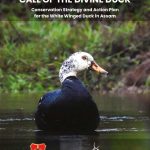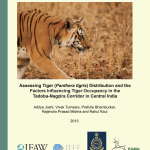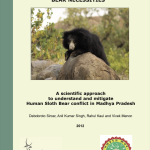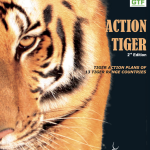Conservation Linkages in the only abode of Markhor in India
Drawing inspiration from unique geography of the Himalaya, its rich diversity of flora and fauna, I have always aspired to work in the lofty velvety green alpine and subalpine meadows with a penchant to work and peek into the ecological diversity of Kashmir. Finally, I had the opportunity to make it happen.
I was a solo traveler from Uttar Pradesh to a long stretch of Jammu-Srinagar highway dotted with potholes and zigzagging the beautiful alpine meadows to make an excited entry to the beautiful valley of Kashmir. As I crossed the Banihal tunnel spanning over 12 km, I was greeted by the appealing charm of the alpine landscape. As soon as I entered the valley, the field team from Wildlife Trust of India (WTI) was waiting to receive me with the warm hospitality of Kashmir. Though it was a stone-cold winter, all set to shiver me and give goose bumps, I was curious to understand and unravel the vistas of valley which was about to unpack its mixed bag of sweet and sour experiences!

Pir-Panjal Range | Photograph by Tahir Gazanfar
Wildlife Trust of India has had a silent history of conservation contributions in the UT of Jammu and Kashmir. Its Markhor (Capra falconeri cashmeriensis) and Hangul (Cervus hanglu) Recovery projects blended both biological and community-driven approaches.
I was assigned the task of assessing the effectiveness of community intervention in Kazinag National Park and the Hirpora Wildlife Sanctuary. With several community-driven interventions successfully implemented in and around these areas, WTI’s major goal under its ‘Species Recovery Projects’ had been to strengthen the community-based conservation and to build and gain trust and support of the local people in the realm of wildlife conservation. From Pradhan Mantri Ujjwala Yojna (PMUY) to Pradhan Mantri Jan Arogya Yojna (PMJAY) to forming Self-Help Groups (SHGs) and promoting eco-tourism, WTI’s social component continues to explore the existing conservation development linkages to address the conservation threats to these flagship wildlife species.
I started my field work in April 2022, by interviewing the migratory herder community members of Gujjars and Bakarwals – known to migrate seasonally to Hirpora and Kazinag areas during the summer season to graze their cattle in the alpine meadows and to get some relief from the sweltering heat of Rajouri and Poonch in Jammu. However, this has been leading to excessive grazing when locals sublet their pastures on rent to unauthorized herders. Over the years, this has resulted in rising competition for forage between the wild ungulates and the livestock.
The front-line staff of the Department of Wildlife Protection, J&K, along with WTI, has also been putting in serious efforts in carrying out anti-grazing drives. The team engages in checking documents including the Matto (grazing permits) and the head count of the livestock and herders is also done. WTI’s protracted consultations with the herders, coupled with the convergence of existing relevant government schemes/programmes has not only resulted in the reduction of livestock in the ‘Critical Markhor Habitats’ but has also developed the trust of herder communities towards the conservation efforts.

Herder consultation at Hirpora WLS | Photograph by WTI
Traveling with the herders, from these pastures to the plains, I moved on to another part of the landscape – the Kazinag NP, to conduct further household surveys regarding the assessment of the community-based interventions.
WTI got almost 500 plus LPG cylinders lined to the families who were earlier not the beneficiaries of the UJJWALA scheme. Almost all the beneficiary families were putting the cylinders to good use, barring some who were still scared of the risks of explosion. Many families also believed that the food cooked on the traditional chulhas is tastier than that cooked on LPG cylinder run stoves. Thankfully, WTI’s survey report showed that the dependency of these people on fuelwood has been on the decline in the fringe areas of both the Hirpora WLS and Kazinag NP. However, the availability and affordability of these cylinders is still a challenge that requires addressing.
Only providing LPG cylinders is not going to reduce the fuelwood dependency on these wildlife habitats. It has to be made sure that these cylinders are being regularly used by the communities by addressing the issue of availability and affordability. This problem can be arrested if other skill development and additional livelihood schemes are introduced in the community. The issue of accessibility can be eliminated by providing separate vendor shops in villages. As a pilot program, a trial on improved cookstoves (chulhas), can be another option.
In my discussion on the issues of accessibility and affordability with Mr. Sameer Khazir (Sociologist and Assistant Manager, J&K, WTI), he asserted that the affordability issue is being addressed through other additional income generating activities like the formation of Self Help Groups (SHGs). Under the umbrella of SHGs, under the DAY-NRLM (National Rural Livelihood Mission) scheme, the women folk receive their initial installments (revolving fund). These women, who were earlier spending time in collecting fuelwood and other NTFPs, are now more involved in attending the SHG meetings, maintaining accounts, lending and borrowing and finally establish bank linkage for small business set ups. Given the pace the women are showing interest in the programme, the SHGs are bound to have good prospects.

Subsidized LPG cylinders being distributed in Limber WLS | Photograph by Akber
The community-based recovery mechanisms of lending and borrowing was however a little thin, much due to the lackadaisical approach of the NRLM Department and poor monitoring at the grass root level. The sociologist is, however, maintaining a persistent liasoning with the administration and has raised this issue with the concerned agencies on several occasions. Being part of one of such meetings conducted under the chairmanship of the District Magistrate, Baramulla, Mr. Sameer raised this issue and ensured prompt action to comply with. The DM directed the District Program Manager to revive the SHGs and plug the loopholes.
At this time when the world has turned into a global village and messages run faster than bullets, these villages nestled in the fringes of Kazinag landscape have been left incommunicado. The liasonning effort in one of our representations to the administrative bigwigs shows the positive reaction towards the network installment in the areas around Kazinag National Park. Such development, Mr. Sameer believes, can highlight the conservation needs and possible solutions while catalyzing collaborative multi-sectorial efforts for biodiversity and human welfare. Therefore, to strengthen the role of local communities in conservation, it is essential to work closely with the government to create supportive government processes and structures.

The Pir Panjal Markhor | Photograph by Shivang Mehta
The interventions should always be apt and contextually appropriate and are to be tailored in the scheme of the local context and local knowledge to resonate with the local communities. We have to see and find an alternative that is ecologically appropriate, decently effective, culturally feasible and economically viable. I believe that such efforts by WTI, supported by Astral Foundation, will lead to positive results in due time.









